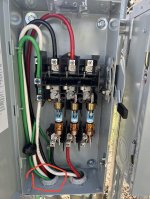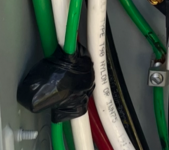Dsg319
Senior Member
- Location
- West Virginia
- Occupation
- Wv Master “lectrician”
Secondary conductors routed in 1.5”LFMC (sealtight) and terminate into the disconnect through concentric knock outs that go up 2”. So there is still one left.
At a minimum the line side from transformer to disconnect needs a bonding bushing/jumper on at least one side correct.
The voltage is 240/120 delta high leg. The reason you only see two conductors is because it is feeding a single phase panel board. Yes I know what a waste but
At a minimum the line side from transformer to disconnect needs a bonding bushing/jumper on at least one side correct.
The voltage is 240/120 delta high leg. The reason you only see two conductors is because it is feeding a single phase panel board. Yes I know what a waste but



